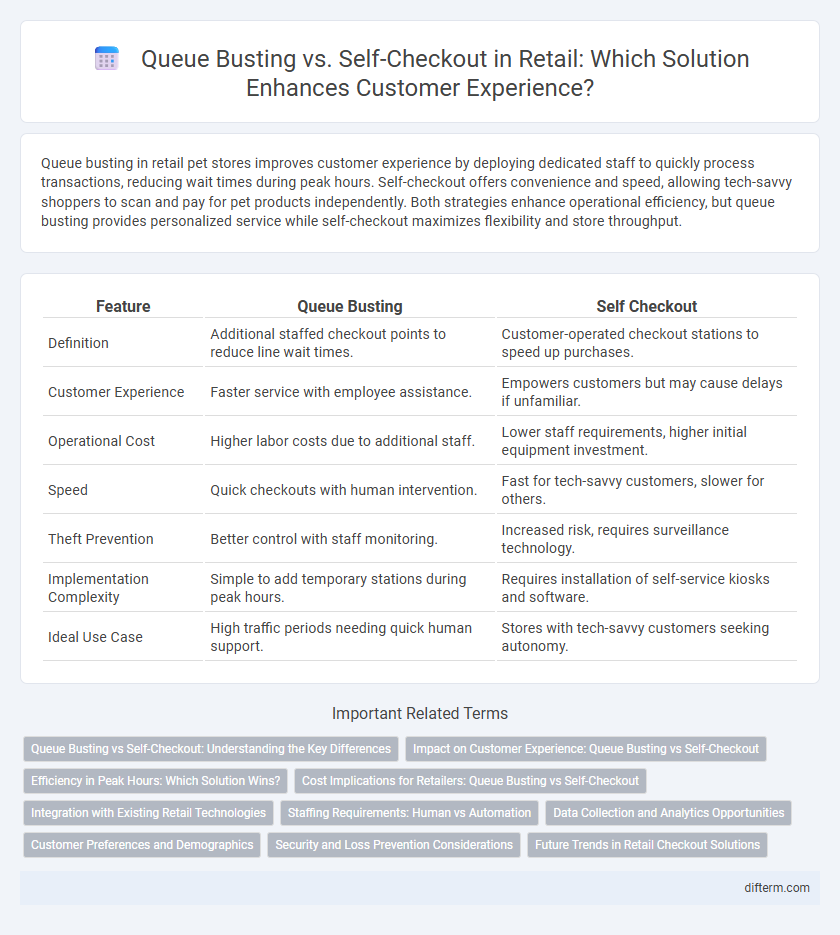Queue busting in retail pet stores improves customer experience by deploying dedicated staff to quickly process transactions, reducing wait times during peak hours. Self-checkout offers convenience and speed, allowing tech-savvy shoppers to scan and pay for pet products independently. Both strategies enhance operational efficiency, but queue busting provides personalized service while self-checkout maximizes flexibility and store throughput.
Table of Comparison
| Feature | Queue Busting | Self Checkout |
|---|---|---|
| Definition | Additional staffed checkout points to reduce line wait times. | Customer-operated checkout stations to speed up purchases. |
| Customer Experience | Faster service with employee assistance. | Empowers customers but may cause delays if unfamiliar. |
| Operational Cost | Higher labor costs due to additional staff. | Lower staff requirements, higher initial equipment investment. |
| Speed | Quick checkouts with human intervention. | Fast for tech-savvy customers, slower for others. |
| Theft Prevention | Better control with staff monitoring. | Increased risk, requires surveillance technology. |
| Implementation Complexity | Simple to add temporary stations during peak hours. | Requires installation of self-service kiosks and software. |
| Ideal Use Case | High traffic periods needing quick human support. | Stores with tech-savvy customers seeking autonomy. |
Queue Busting vs Self-Checkout: Understanding the Key Differences
Queue busting involves deploying additional staff or mobile payment devices to speed up transactions during peak retail hours, enhancing customer experience by reducing wait times. Self-checkout systems allow shoppers to scan and pay for items independently, offering convenience but sometimes causing delays due to user errors or technical issues. Retailers must evaluate factors such as labor costs, customer preferences, and transaction speed to determine whether queue busting or self-checkout optimally improves operational efficiency and shopper satisfaction.
Impact on Customer Experience: Queue Busting vs Self-Checkout
Queue busting enhances customer experience by reducing wait times through mobile point-of-sale systems operated by employees, providing personalized service and faster transactions. Self-checkout offers convenience and autonomy, appealing to tech-savvy shoppers seeking quick, independent purchases but may cause frustration due to technical glitches or lack of assistance. Retailers balancing queue busting with self-checkout can optimize efficiency and customer satisfaction by catering to diverse preferences and minimizing bottlenecks during peak hours.
Efficiency in Peak Hours: Which Solution Wins?
Queue busting solutions enhance efficiency during peak retail hours by deploying additional staff or mobile point-of-sale devices to reduce wait times and maintain a personalized customer experience. Self-checkout systems enable multiple customers to process purchases simultaneously, decreasing congestion but often require customer familiarity with technology and may lead to scanning errors. Retailers seeking optimal efficiency during high-traffic periods should weigh queue busting for immediate human intervention against self-checkout for scalable throughput and reduced labor costs.
Cost Implications for Retailers: Queue Busting vs Self-Checkout
Queue busting minimizes labor costs by deploying mobile POS devices to process transactions quickly during peak times, enhancing staff flexibility without permanent infrastructure investment. Self-checkout requires significant upfront costs for kiosks and ongoing maintenance but reduces the need for cashier staffing long-term. Retailers must balance initial capital expenditure of self-checkout systems against the variable labor savings and improved customer throughput offered by queue busting solutions.
Integration with Existing Retail Technologies
Queue busting solutions seamlessly integrate with existing POS systems and mobile payment platforms, enabling faster transaction times without disrupting retail workflows. Self-checkout technology requires compatible hardware and software synchronization with inventory management and loss prevention systems to maintain operational efficiency. Both approaches benefit from real-time data integration, enhancing customer experience and store performance metrics.
Staffing Requirements: Human vs Automation
Queue busting requires strategically placed staff to assist customers and expedite transactions, demanding flexible shift planning and real-time management of personnel. Self-checkout reduces the need for cashiers, shifting staff roles to monitoring machines and helping with technical issues, which lowers overall labor costs but necessitates investment in training for technology support. Balancing queue busting and self-checkout optimizes staffing by combining human interaction for complex tasks with automation efficiency to streamline operations in retail environments.
Data Collection and Analytics Opportunities
Queue busting solutions generate real-time data on transaction speed and peak wait times, enabling retailers to optimize staffing and improve customer flow. Self-checkout systems provide detailed insights into product scanning patterns, basket composition, and frequent checkout issues, facilitating targeted inventory management and personalized marketing strategies. Both technologies supply granular customer behavior data, but queue busting excels in operational efficiency metrics while self-checkout emphasizes consumer purchasing analytics.
Customer Preferences and Demographics
Customer preferences in retail reveal that younger demographics, particularly millennials and Gen Z, show a strong affinity for self-checkout systems due to their speed and technological engagement. Conversely, older customers often prefer queue busting staffed registers, valuing personalized service and assistance. Retailers analyzing transaction data find that blending both options caters to diverse customer needs, maximizing satisfaction and operational efficiency.
Security and Loss Prevention Considerations
Queue busting uses mobile POS devices to expedite transactions but requires stringent employee training and secure device management to prevent internal theft and data breaches. Self-checkout systems rely on automated scanning and payment processes, increasing vulnerability to theft through barcode switching and non-scanned items; implementing AI-powered video analytics and weight sensors can enhance loss prevention. Both solutions necessitate robust security protocols and continuous monitoring to minimize shrinkage while maintaining transaction efficiency.
Future Trends in Retail Checkout Solutions
Queue busting technologies leverage mobile devices and AI-powered assistants to expedite the checkout process, reducing wait times and enhancing customer satisfaction. Self-checkout systems continue to evolve with biometric authentication and cashless payments, offering seamless and secure transactions that minimize staff requirements. Future retail checkout solutions will integrate IoT and real-time analytics to create personalized, efficient, and contactless shopping experiences.
queue busting vs self checkout Infographic

 difterm.com
difterm.com